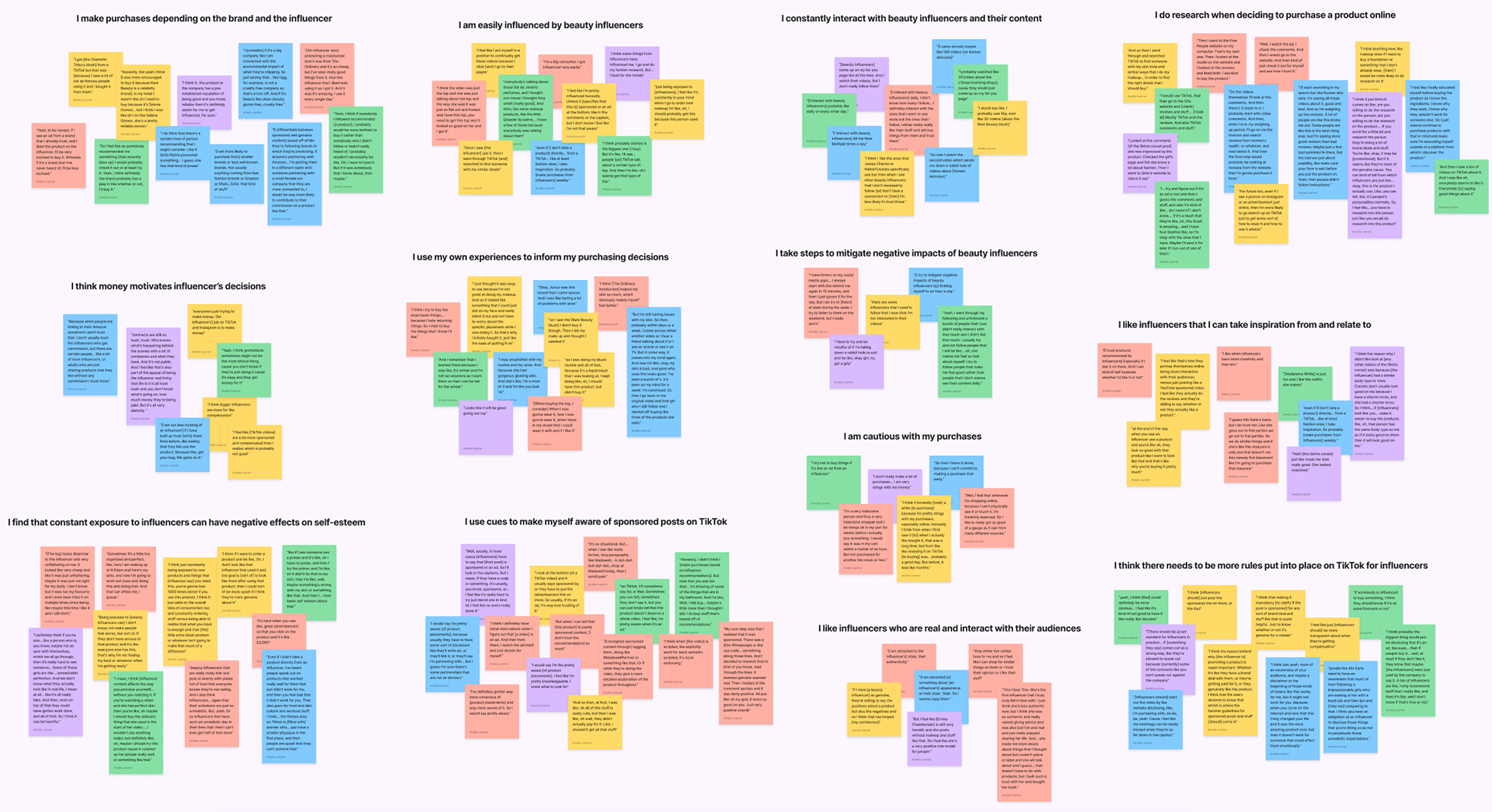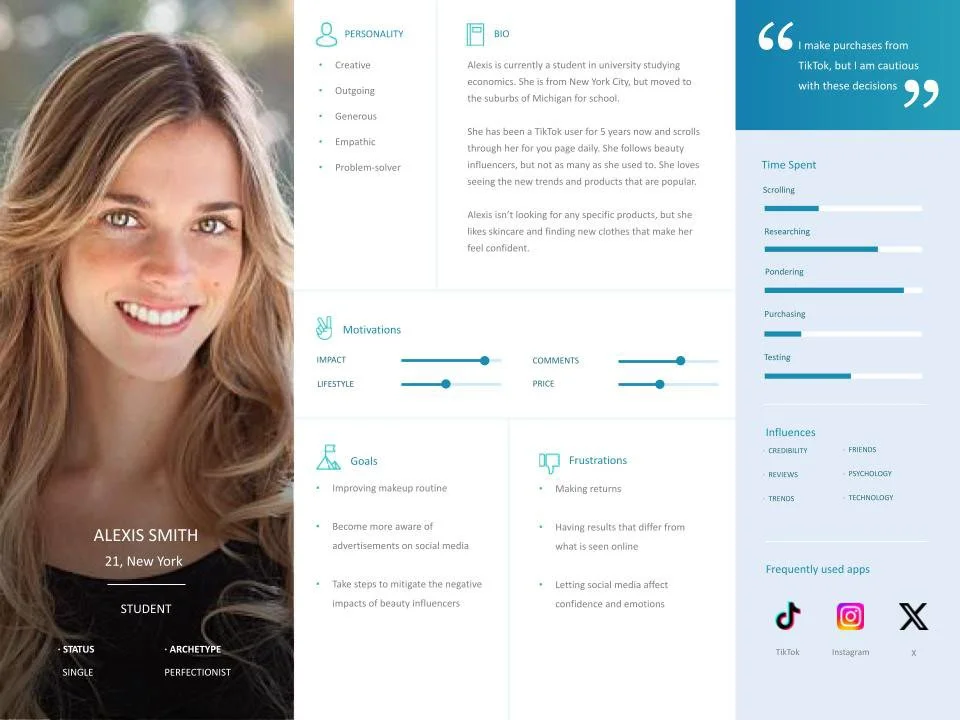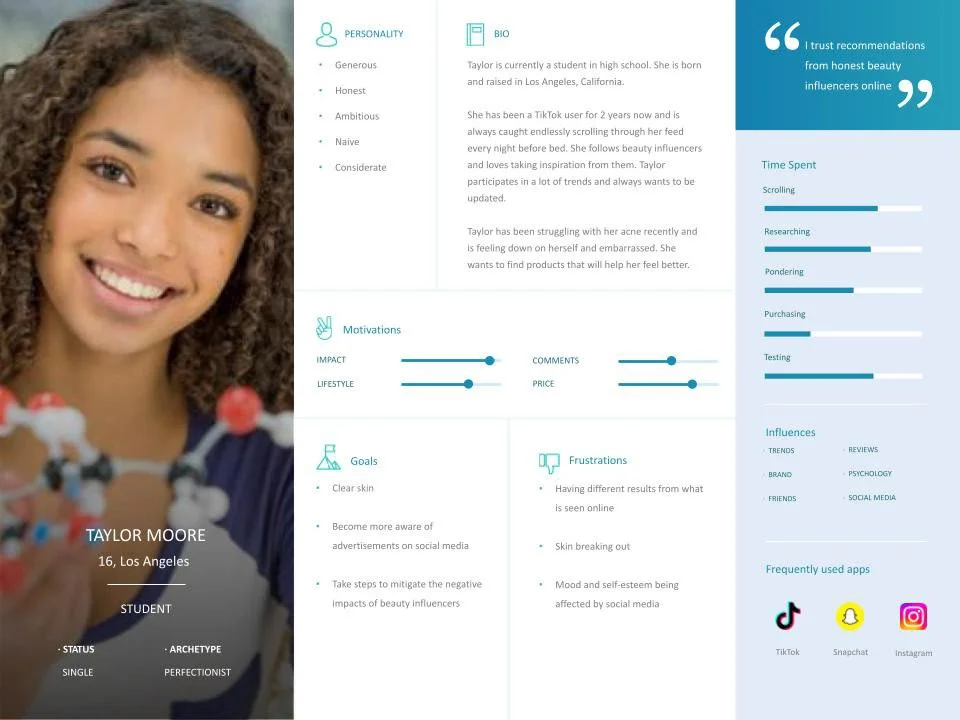TIKTOK
Research & Usability Testing
Overview
Understanding how beauty influencers impact users’ wellbeing
Scope
Interviewing, journey mapping, persona development
Tools
Google Forms / Zoom / Figma / Google Presentation
Timeline
10 weeks
With nearly 5 billion social media users worldwide, over half the global population and 90% of the U.S. population, social media has become a cornerstone of daily life. People now consume an unprecedented amount of media, with product placements seamlessly integrated into their feeds, often going unnoticed. This subtle integration makes it difficult for users to recognize the effects these placements can have on their perceptions and behavior.
The average young adult (ages 16–24) spends nearly six hours a day on social media, a period in life when individuals are particularly impressionable. Many in this age group may not fully grasp the potential negative impacts of their consumption, including the effects on self-esteem and mental health.
Over the course of the semester, I explored how product placements contribute to misrepresentation on social media, ultimately shaping users' self-perceptions and mental well-being.
Objective
The aim of my research was to see how beauty influencers and product placements affect a user’s experience on TikTok. This research focuses on understanding these key attitudes and behaviors:
1. Comparison
2. Awareness of advertisements
3. Emotional and physical response
a. Purchasing behavior
b. Content engagement
c. Coping mechanisms
Background
How might we create a positive relationship between beauty influencers and TikTok users?
-Understand current painpoints users face when scrolling through their ‘For You’ page
-Can we identify any patterns?
-Determine user preferences for product placements and beauty influencers
-How does this alter their online purchases?
-Evaluate the impact of TikTok on a user’s wellbeing
-Determine if there are any changes TikTok can implement to create transparency
Process
1. Sent out UX Research screener form to a network of 20+ people across the United States
2. Filtered through the responses and sent out consent Google Form to my chosen interviewees
3. Conducted interviews over Zoom with mapping activity (generative method)
4. Coded interview data to find key themes
5. Completed thematic analysis based on all five interviews
6. Created deliverables (journey map and personas)
-Requirements
-Identify as female
-16 - 24 years
-United States of America
-All use TikTok daily and interact with beauty influencers
-Recruitment Survey
-n = 8
-Interview
-n = 5
Participants
Along with my interview questions, I asked my participants to map out the timeline or process of a time they saw a product on TikTok and considered purchasing it. They marked the key feelings, thoughts, and actions that they went through to purchase the product or deciding not to purchase it. These maps gave me insight into their through process and how they interact with TikTok in order to help me create my final journey map deliverable.
Insights - Thematic Analysis
I developed 13 themes based on responses, which I then synthesized into three core themes:
Users use research and their own experiences when deciding to purchase a product
All of my participants discussed doing further research into a product that they find on TikTok by going to other sites and videos to make sure they find trustworthy reviews and trust the product before purchasing. Many also use their past experiences and current needs such as problems with skin and events they have coming up.
Users find that constant exposure to influencers have negative effects on self-esteem
Many people talked about their experiences online and how seeing certain influencers and products would make them feel bad about themselves. My participants have had problems with their skin, body image, and more. By seeing beauty influencers who portray a certain lifestyle or look that a typical user cannot maintain, it creates negative feelings. There is a lot of comparison as people wish they could have that perfect smooth skin or small waist.
Users use cues to spot sponsorships, but think there should be more rules
Some of the main themes surrounding sponsorships revolved around their awareness and the regulation by TikTok. There are certain cues such as #ad or the sponsored box in the bottom left corner of a video that my participants use to determine what posts include product placements. The participants were less trusting of content when they realized it was sponsored and a majority would scroll past quickly. They think that there should be more rules put in place for influencers to ensure they are transparent about when they are making money off of a post.
Personas
Created two personas to represent the various experiences of my participants. Older women in the 16-24 age range tended to be more secure online and sure with themselves compared to the younger women. They also were less likely to be influenced and had more positive experiences on TikTok. All of the details in my personas were pulled from responses of my participants and by making two separate ones for the younger and older women, I covered a majority of the experiences discussed.
Deliverables
Journey Mapping
I focused on one of my personas to create a journey map for. I chose Taylor Moore because she reflected the negative experience and most of my participants mentioned problems they have encountered with TikTok so thought it would be more representative of the majority. I chose to go through the buying experience starting with scrolling on TikTok to finally purchasing the product and including her reaction to it. I felt that the broad word “product” was not specific enough to the experiences of my participants and so I chose a makeup product because it seemed that a majority of my younger participants are mainly influenced by this realm of beauty since skincare is too dependent on a person’s skin type.
I covered my key findings in my journey map by including how Taylor thinks about her relationship with the influencer, does research to inform herself, considers if the post is sponsored, and thinks about the price of the product as all of this was mentioned in my thematic analysis.
Conclusions
Key Findings
I found that my participants of all ages were more likely to follow and trust influencers that were open and honest and truly felt real. People they can relate to feel more trustworthy as they can compare their own experiences to the influencer in order to make informed decisions. Along with this, it seemed that while the interviewees had some level of trust with the influencer, when choosing to make a purchase from their recommendations, they did much more research on both TikTok and other sites to ensure that the product would work for them too. They consider the credibility of both the brand and the influencer before making a purchase. Another one of my main findings was surrounding sponsored posts online. Many of my participants mentioned money as a motivator for influencers and so they try to be cautious of promotional content by using cues, but they think more regulations should be put in place by the social media platforms to ensure that users are constantly aware of sponsorships as sometimes they unwittingly succumb to the allure of a sponsored post.
Design Recommendations
Currently, many videos have #ad and other hashtag indicators hidden further down in the caption of the video to make it more difficult to ascertain if it is sponsored upon first glance. A proposed design change will have a clear block above the caption that says “sponsored” to make any advertisement easy to spot.
Next Steps
If given the opportunity to access more resources and reach a further audience, I would be interested in completing A/B testing for the current and proposed design to compare the experiences of the users. Along with this, understanding how men or those of other genders interact with the TikTok interface and how they are affected by influencers could be extremely interesting. I could compare and contrast with the research findings above. To get comprehensive findings, I would want to interview more people to get a wider variety of perspectives.
Other questions to answer:
1. How could we design TikTok for a brand's experience that allows them to select more trusted creators to promote their products?
2. What could we learn about a user’s research process across TikTok? Are there spaces to enhance the exploratory journey so users don’t have to leave TikTok to find the info they need?
Lessons Learned
Throughout this research process, I learned the significance of an organized plan and clear research questions prior to completing any interviews. This helped me maintain a strong focus throughout my work and stay on track. Additionally, I had to navigate the challenges of bias and subjectivity. I had to remain objective throughout the research process and ensure I gathered people from diverse backgrounds.
Limitations
Sample size and representation
I had limited time and resources to interview a large number of people with diverse experiences and backgrounds
Time constraints
As each step of the project was to be completed in a week, I might not have achieved as thorough results as I could have if I had a longer time frame to work on it
External factors
There could have been potential updates with the TikTok application or changes in the algorithm that may affect a user’s experience
Sources
Georgiev, D. (2024, January 3). How Much Time Do People Spend on Social Media in 2024?. TechJury. https://techjury.net/blog/time-spent-on-social-media/
Kosmin, J. (2023, August 8). How Does Social Media Negatively Impact Youth?. Malvern Behavioral Health. https://www.malvernbh.com/blog/negative-impact-of-social-media-on-youth/




